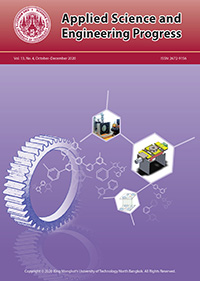Piper Trilinear and Gibbs Description of Groundwater Chemistry in Port Harcourt, Nigeria
Main Article Content
Abstract
Several studies have shown that there are high salinity values in the groundwater quality in certain areas within Port Harcourt city. However, a detailed investigation on the cause is not yet documented hence, this research investigated the factors governing the hydro-geochemistry of the said area. This was achieved by analysing concentrations of 7 ions (both cations and anions) and total dissolved solids (TDS) in water samples obtained from 26 drilled boreholes and 4 hand dug wells, evenly distributed within the study area. The examined ions are Ca2+, Mg2+, Na+, K+, Cl–, HCO3– and SO42–. Laboratory results were plotted on Piper trilinear and Gibbs diagrams through Aquachem 5.1 software package and it was revealed that 63.33% of the total samples fell in Na-Cl hydrochemical facies while the remaining 36.67% occurred in Ca-Cl facies. It was also revealed that the controlling factors for formation of the analysed ions were precipitation and rock weathering on 76.67% and 23.33% respectively. Hence, it was concluded that Na-Cl facies is the dominance hydrochemical facies in the study area while the main factor governing the formation of ions is precipitation. However, it was recommended that the rate of pumping out water from wells in certain parts of the study area should be reduced in other to avoid seawater intrusion.
Article Details
References
[2] K. Gopal, “Groundwater salinity,” Current World Environment, vol. 14, no. 2, pp. 186–188, 2019.
[3] E. I. Christopher and A. T. Joseph, “Assessment of urban groundwater quality using piper trilinear and multivariate techniques: A case study in the Abuja, North-Central, Nigeria,” Environmental Systems Research, vol. 8, no. 14, pp. 1–14, 2019.
[4] P. S. Luhut, R. Reza, and N. Janner, “Hydrochemical and groundwater assessment for drinking purpose at ITERA campus area and its surroundings,” Journal of Geoscience, Engineering, Environment and Technology, vol. 4, no. 1, pp. 40–48, 2019.
[5] K. M. Adam, L. Dan, S. Kai, A. A. Mohamed, A. Elsiddig, and A. E. Basheer, “Hydrochemical analysis and fuzzy logic method for evaluation of groundwater quality in the North Chengdu Plain, China,” International Journal Environmental Research and Public Health, vol. 16, no. 3, pp. 302–308, 2019.
[6] W. Wilopo, D. P. Eka, H. Setiawan, and R. Susatio, “Groundwater flow patterns and hydrochemical facies of Kendal groundwater basin, Central Java Province, Indonesia,” IOP Conference Series: Earth and Environmental Science, vol. 361, pp. 1–8, 2019.
[7] P. T. Phyu, H. Heru, W. Wahyu, and K. Satoru, “Assessment of groundwater facies in Wates Coastal Area, Kulon Progo, Yogyakarta, Indonesia,” Journal of Degraded and Mining Lands Management, vol. 5, no. 4, pp. 1389–1401, 2018.
[8] L. Yingzhi, L. Jiutan, G. Zongju, W. Min, and Y. Leqi, “Major ion chemistry and water quality of groundwater in the Shigaze urban area, Qinghai- Tibetan Plateau, China,” Water Supply, vol. 20, no. 1, pp. 335–347, 2020.
[9] A. S. Hussein, R. E. Mohamed, A. Mohamed, and Y. B. Gamal, “Effect of the Nile Aquifer lithological characteristics in Assiut Governorate, Egypt,” Journal of Ecological Engineering, vol. 20, no. 6, pp. 73–83, 2020.
[10] H. Afshin, A. Aliasghar, N. Fashime, M. Milad, E. Mobin, and O. Yaser, “Hydro-chemical assessment and GIS-mapping of groundwater quality parameters in semi-arid regions,” Journal of Water Supply: Research and Technology, vol. 68, no. 7, pp. 509–522, 2019.
[11] K. Rakesh, C. Sudesh, and Y. Sudesh, “Anthropogenic influences on the hydrochemistry and water quality of groundwater in Sigrauli Power Belt Region, Central India,” Proceedings of Indian National Academy, vol. 85, no. 3, pp. 637–658, 2019.
[12] P. Makri, D. Hermides, M. Psychogiou, and A. Ermidou, “The use of geochemical ratios in groundwater quality assessment: The case of the Thriassion Plain, Attica, Greece,” Bulletin of the Geological Society of Greece, vol. 55, no. 1, pp. 223–240, 2019.
[13] S. Akhigbe, G. M. Udom, and H. O. Nwankwoala, “Impact of domestic and industrial waste on surface and groundwater quality within slaughter area, trans-amadi industrial layout, port harcourt, Nigeria,” International Journal of Waste Resources, vol. 8, no. 1, pp. 1–8, 2018.
[14] C. P. Ukpaka and C. Ukpaka, “Characteristics of groundwater in port harcourt local government area,” Chemistry International, vol. 2, no. 3, pp. 136–144, 2016.
[15] F. J. Ogbozige and M. I. Alfa, “Land use-land cover effects on surface flowing water quality: A statistical approach,” Nigerian Journal of Technological Development, vol. 16, no. 1, pp. 25–35, 2019.
[16] APHA, Standard Methods for Examination of Water and Wastewater, 25th ed. Washington DC: American Public Health Association, 2012.
[17] AquaChem v.5.1 User’s Manual: Water Quality Data Analysis, Plotting and Modeling. Canada: Waterloo Hydrogeologic Incorporation, 2007.
[18] V. M. Wagh, D. B. Panaskar, A. M. Varade, S. V. Mukate, S. K. Gaikwad, R. S. Pawar, A. A. Muley, and M. L. Aamalawar, “Major ions chemistry and quality assessment of the groundwater resources of Nanded Tehsil, a part of Southeast Deccan Volcanic Province, Maharashtra, India,” Environmental Earth Sciences, vol. 75, no. 1418, pp. 1–26, 2016.
[19] P. Caecilia, S. Ketut, N. Yustina, and H. Prasetyo, “Removal of Mg2+, K+, SO4 2– Ions from seawater by precipitation method,” in MATEC Web of Conferences, 2016, vol. 58, p. 01022.


